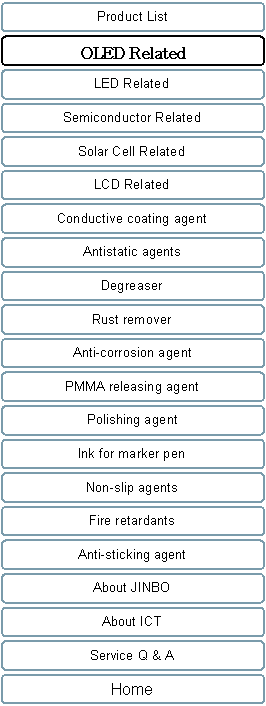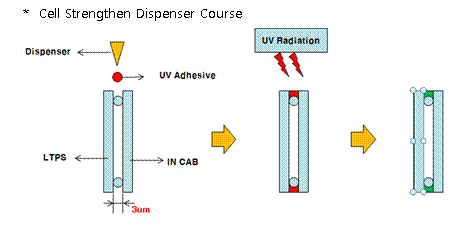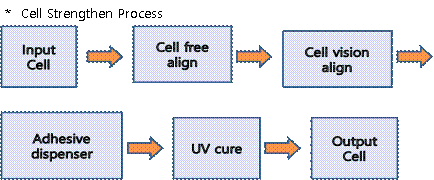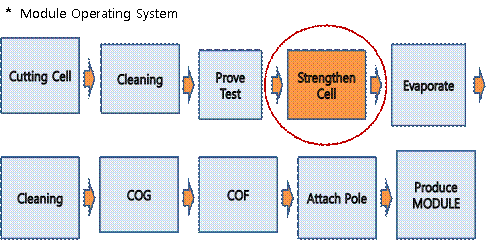
|
Development of tailor made products |
|
OLED Related |
|
JINBO CO., LTD |
|
JINBO |


Related to Organic Light Emitting Diode |

|
An OLED [Organic Light-Emitting Diode] is a self luminescent light which emit lights on the organic compound film in response to an electric current. The display is different from a LCD which is light emitting by back light, but OLED is self emitting display without any external drivers. OLED screen can achieve 1,000 times faster response, more vivid color gamut, higher contrast ratio and a wider viewing angle than a TFT LCD. |
Product Name: JB-UV228 |
|
There are two main family types of OLEDs. They are Passive Matrix (PMOLED) and Active Matrix (AM), each has a slightly different mode of operation. PMOLED emit all lines of a group together, while AMOLED displays each individual pixel (on or off operation system).
AMOLED generates a self light display (luminescent) upon electrical activation in the organic film of the florescent or phosphorescent between Electron and Hole. The Light color variation depends on the composition of the organic compound. AMOLED response time is a microsecond (μs), 1,000 times faster than TFT LCD of a millisecond (ms). The afterimage of TFT LCD remains due to the slower speed. Since AMOLED is a self emitting light and operate without required back light units, resulting in approx a one-third reduction of thickness and weight then in a TFT LCD. This additional space provide room for a larger battery capacity.
Additionally, compared to TFT LCD, AMOLED technology enables more vivid in both high and low temperatures. Due to the self emitting system, the brightness and contrast range does not change based on the viewing angle. Herby providing a clearer view due to the bright light and solved view angle problem.
To date, manufacturing cost has been a major barrier to the adoption of OLED technology compared to traditional TFT LCD which is priced lower. Now, that is all about to change. Use of our AMOLED adhesive could result in improved processing. This could result in an increase demand in the display market of the WiBro, DMB and other.
JB-UV228 is a high performance adhesive of UV/VIS cure type for a OLED Cell. Current concrescence surfaces come apart by the shock or vibration of the products which is due to the lose of a bonding strength between LTPS and IN CAB at the AM-OLED [Active Matrix Organic Light-Emitting Diode]. To improve the coupling strength, inject our adhesive to the surface after completion of the cell cutting. Our product is also an excellent water proof sealant of TFT LCD’s contained in mobile phones.
|
|
* Curing condition In exposure of 365~420nm radiation beam the product cure, This curing speed and maximum depth is dependant on the strength of beam, spectrum distribution of light source, exposure time, adherence beam transmittance of substrate. 1second@350mW/cm2, 365nm (Metal Halide, UV hardener)
* Storage JB-UV228 is sensitive to sunlight, seal stored in a refrigerator at 1~10℃, avoid UV ray and minimize artificial lighting during the storage and handling. If stored at temperatures over 10℃ the physical characteristics will be effected. |
|
JINBO: 82-54-336-3578 Fax: 82-54-332-3588 INSTITUTE: 82-54-334-3588 jinbo357@naver.com |

|
Items |
Results |
|
Chemical Type |
Urethane Acrylate |
|
Appearance |
Yellowish Transparent Liquid |
|
Component |
Single Component |
|
Curing Method |
UV/VIS Light Exposure |
|
Typical Applications |
Fixing of Component |

|
Items |
Results |
Remarks |
|
Viscosity (cps at 25℃) |
100~150 |
Brookfield DV-II+Pro, Spindle#2, 20rpm |
|
Specific Gravity (at 25℃) |
1.0~1.2 |
Fisher, Hydrometer |
|
Shelf Life (at 1~10℃) |
6months |
|

|
* Physical characteristics of a cured adhesive |


|
Items |
Results |
|
Hardness (Durometer D) |
60~70 |
|
Corrosion (95%RH, 95hr at 40℃) |
None |
|
Moisture Absorption (24hr at 25℃ in water) |
≤1.0 |
|
Insulation Resistance (95%RH, 95hr at 40℃) |
≥1ⅹ1012 |
|
Thermal Resistance (sec at 245~285℃) |
11~15 |
|
Chemical Resistance (IPA, 24hr at 40℃) |
≤0.1 |